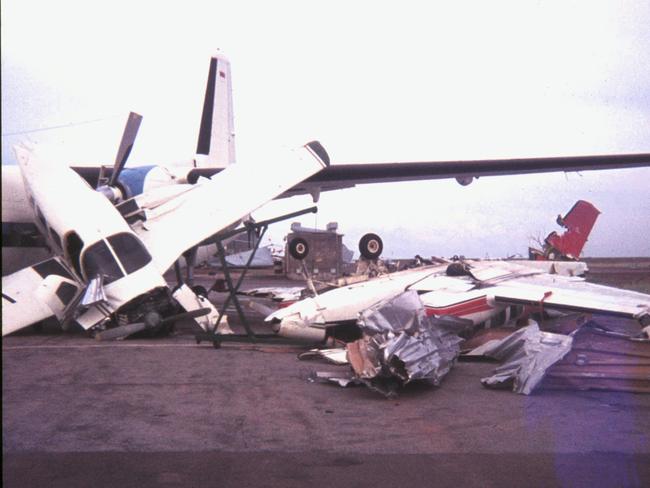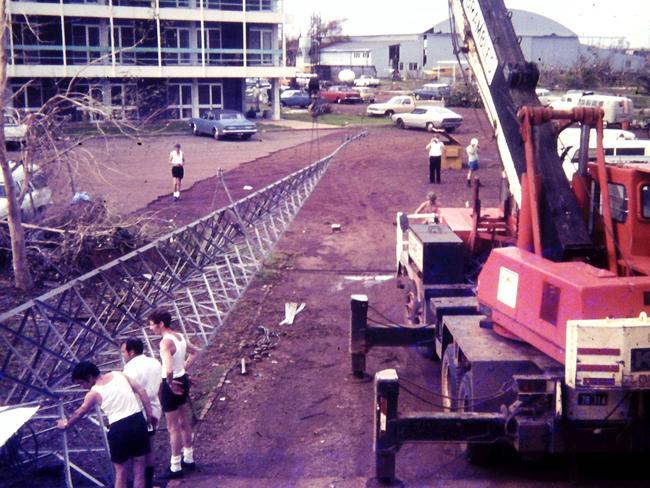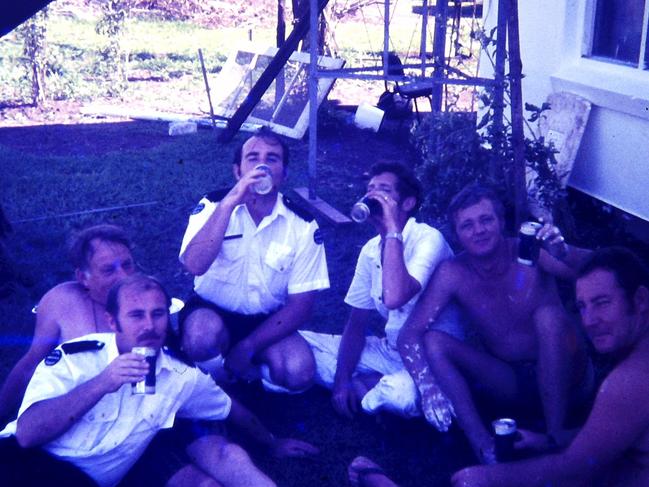SA’s ‘Dirty Dozen’ remembers Cyclone Tracy 50 years after they flew into the disaster zone
It’s been 50 years since 12 men answered a call for help, with no idea what they were flying into or when they would be coming home.
SA News
Don't miss out on the headlines from SA News. Followed categories will be added to My News.
Cyclone Tracy – 1974. They were known as the Dirty Dozen – 12 young South Australian ambulance officers, dispatched to Darwin with little notice, after Cyclone Tracy obliterated the laid-back city in the early hours of Christmas Day, 1974.
A total of 66 people lost their lives and 145 more were seriously hurt when howling winds of up to 217km/h tore through, leaving 41,000 of the city’s 47,000 residents homeless.
Our ambos, dubbed the Dirty Dozen by Territory locals, were later joined by 23 South Australian police officers. They left Adelaide with little idea of when they’d be home.
Darwin resembled a nuclear wasteland. Twisted car wrecks and stobie poles bent over at right angles, fridges wedged high in water tanks and home after home, completely flattened. Animals and birds didn’t survive. It was eerily quiet.
The team was confronted with apocalyptic scenes, now forever etched in their minds. Our nation had never seen a disaster like it.
This Christmas marks 50 years since Cyclone Tracy and some of our first responders are planning to return for commemorations.
Local police officers assigned to the trip included constables Ian DeLaine, Craig Drogemuller, Ashley Pursche, Peter Giles and Graham England.

The “Dirty Dozen” was made up of operations manager Peter Gebert, second in charge Don DeGiglio, Lee Francis, Mike Horsman, John Burton, Graham Stewart, Ray Benzie, Peter Simms, John Pohl, Malcolm Pascoe, Bob Campbell and Charlie Stal.
They were deliberately chosen for their varied skills. Pascoe, Francis, Stal and Horsman had army experience, Stewart and Benzie were ex-navy, Simms was a trained electrician, Pohl a skilled mechanic.
I caught up with some of those sent to the disaster zone.
John Pohl was celebrating his sister-in-law’s wedding at Eudunda when he was plucked out, and told to get back to Adelaide, to board the flight for Darwin.
Lee Francis was happy to go, as long as he was home for his own wedding in early March.
SAPOL’s Ian DeLaine had planned to propose to his wife on her January 6 birthday, but had to pop the question on New Year’s Eve before he flew out.
Don DeGiglio remembers the chaotic scenes as their plane came in to land. “When we flew in, I remember them saying ‘get the blokes neat and tidy, hats, ties on and jackets on’,” Don says.




“They were still clearing the airstrip with bulldozers. As we were getting off, there were thousands of people queued up trying to get out of town.”
Tens of thousands of men, women and children fled Darwin in the days and weeks after the disaster. There was no safe drinking water, electricity or shelter. The risk of disease was high.
A luxury coach that came to collect the SA crew had a gaping hole in its side.
The airport, with twisted planes piled on top of each other, resembled a movie set.
Washing machines were pressed up against telegraph poles, trees became sticks, stripped of all their bark and leaves, bits of straw were driven through planks of wood and sheets of corrugated iron were wrapped like alfoil, around anything left standing.
Lee Francis remembers the heat, the moment the plane door opened.
“The air in Darwin was as hot and thick as hell. It was like trying to breathe through porridge,” he says.
Getting fresh water was impossible.
“Water was the most important thing we needed, but they supplied us with XXXX beer – you couldn’t get water,” now retired police officer Ian Delaine says. “You’d clean your teeth in a can of beer.”




The team was put straight to work. For our police, it was searching for any survivors, or bodies.
“They put us into vehicles that had been seconded from car yards,” he says. “We had to search from top to bottom, primarily for people. We pumped pools out, the water was black, to make sure no one was in them.
“We opened every fridge and freezer to make sure no one was there, that’s a place they would hide.
“If there was anything of any value, bag it up, if there were any firearms – destroy them and any explosives.”
Tensions ran high in the early days. The local ambulance crews saw our “Dirty Dozen” as intruders.
But they earned respect, working 18 hours a day for the first week. There was little medical work to do because most residents had been evacuated, shocked and dazed. The crews spent most of their time securing basic healthcare products.
“A pharmacy had lost its roof and windows, from there we took everything from sanitary needs to dental and baby food,” Lee Francis says.
“We took it to the local high school, which police had put a perimeter fence around. It was stored in there and shared with those who needed it.”



The team helped with vehicle and generator maintenance, and in searches through people’s lives.
“I was just a simple country boy from up in the Hills,” John Pohl says.
“I’d never seen a dead body, so for me it was very much an eye-opener.”
Communication to the outside world was almost impossible, but on New Year’s Eve, Lee Francis joined a queue of more than 100 men to call his fiancee Ann.
“PMG/Telecom had worked flat out and reconnected a triple bank of public phone boxes and we got a free one-minute operator-connected phone call to one number anywhere in Australia,” he says.
“They were the only phones in town. I got through to Ann about 0300 hours, which was fabulous and really appreciated.”
Malcolm Pascoe remembers a touching moment, just before the team flew out from Adelaide.
“A lot of family members came to the airport to see who was coming off the plane from Darwin,” he says.



“A woman came up and said ‘I’ve got a letter for a relative, if I give you the address, will you take it and see if you can find them?
“I did and it was the only house left standing in the street. I handed it over and they were so chuffed to get it. They hadn’t heard from anyone.”
Our ambulance officers negotiated a living-from-home allowance of $2. Police slept in stretchers on the floor of an empty office building.
They left Adelaide with a sense of adventure and returned with lifelong memories and unbreakable bonds.
In the lead-up to the 50-year anniversary, two memorials will be built in Darwin, honouring those who lost their lives, the survivors and those, like our police and the Dirty Dozen, who helped rebuild a city, forever changed.



